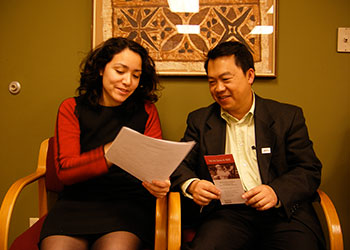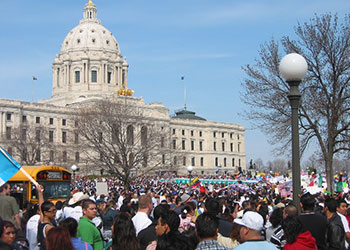News > Fact Sheets
Fact Sheet: Temporary Protected Status for Burma (Myanmar) (Updated 8.4.2021)
Posted on Jun 11 2021
This fact sheet was originally published on June 9, 2021 and was updated on August 4, 2021.
On Friday, March 12, 2021, Secretary of Homeland Security Alejandro N. Mayorkas designated Burma (Myanmar) for Temporary Protected Status (TPS) for 18 months. The move comes in response to the coup on February 1, 2021 and the ensuing crackdown on protesters.
What is temporary protected status (TPS)?
The Secretary of the Department of Homeland Security (DHS) grants TPS to individuals from designated countries who are unable to return home safely due to conditions or circumstances in their home countries.
During the designated TPS period, TPS holders are allowed to live in the United States and cannot be detained by DHS just on the basis of their immigration status. TPS holders are eligible to apply for an employment authorization document (EAD) and for travel authorization.
What does the designation of TPS for Burma (Myanmar) mean?
This new designation enables citizens of Burma and individuals without nationality to file applications for TPS if (1) they were living in Burma (Myanmar) right before coming to the US, and (2) they have resided continuously in the United States since March 11, 2021. If you left for any reason, talk to an immigration attorney.
When can I apply for TPS for Burma?
The registration period determines how long individuals have to apply for TPS. Under Burmese TPS, individuals can apply from May 25, 2021 until November 25, 2022.*
*This is an update from an August 4, 2021 Federal Register notice. DHS is extending the initial registration periods from 180 days to 18 months for applicants who do not currently have TPS under the TPS designations for Burma. This extension to 18 months is the same time period of the TPS designation itself, allowing an individual to apply as an initial applicant any time during the 18-month designation period.
How long will I have protection under TPS for Burma?
The designation period determines how long TPS and the protections under TPS are valid. TPS is a temporary status. The Secretary of Homeland Security Alejandro N. Mayorkas is designating Burma (Myanmar) for TPS for 18 months, until November 25, 2022. In September 2022, a decision will be made to extend TPS status or no, depending on the situation in Burma.
Who is eligible for TPS under the Burma (Myanmar) designation?
Burmese nationals who do not have legal status in another country, and people without nationality who last regularly lived in Burma (Myanmar) and who currently live in the United States may file applications for TPS. They will have to prove that they resided continuously in the United States as of March 11, 2021.
People interested in TPS must file an application with U.S. Citizenship and Immigration Services by November 25, 2022. They may also apply for Employment Authorization Documents (EADs) and for travel authorization. All individuals applying for TPS undergo security and background checks as part of determining eligibility. More details about the eligibility criteria to submit an initial TPS application and apply for an EAD can be found in the Federal Register Notice (FRN).
Is TPS status given automatically?
No, TPS is not automatic. People must apply, pay a filing fee, and pass immigration screening. There are some facts that will make a person ineligible for TPS. For example, people with certain criminal convictions or who violated the human rights of others are not eligible for TPS. People who are inadmissible under certain sections of the law may have to file a waiver before they can be approved for TPS status. The application process can be complicated, and we recommend working with an immigration attorney.
I have been in the United States since before March 11, 2021, but I have left for short periods of time. Can I apply for TPS?
Maybe. Whether you still qualify for TPS depends on the length and nature of your time outside of the United States. Please contact an immigration attorney to discuss your situation further.
I am from Burma (Myanmar), and I came to the United States as a refugee. Do I need to apply for TPS?
No. People who are in the US with refugee status can live and work here and apply for permanent resident status after one year. They do not require TPS.
I am from Burma (Myanmar), and I now have a green card. Do I need to apply for TPS?
No. As a permanent resident, you have legal status in the US and are on a path to citizenship. You do not need and would not qualify for TPS.
I am from Burma (Myanmar), and I am in deportation proceedings. Can I apply for TPS to avoid deportation?
Yes. A person in removal proceedings can apply for TPS, and if approved, can request that the judge put the removal case on hold until TPS is approved, and then for the time it is in effect.
I am from Burma (Myanmar), and the police have given me tickets here. Can I apply for TPS?
Maybe. You need to show your tickets to an immigration lawyer before filing. A person with two misdemeanors or one felony cannot get TPS. A lawyer can tell you if the tickets will be a problem.
Which people from Burma (Myanmar) should consider applying for TPS?
People who are here with no legal status should consider applying. Also, those who are here on a visa that is for a limited time or that does not allow for working might also benefit by receiving Temporary Protected Status. Having TPS does not hurt anything.
*If you are from Burma (Myanmar) and came to the United States on a F1 student visa, contact your school’s international student office for more information.
Get Help
The Immigrant Law Center of Minnesota (ILCM) provides free immigration legal services to low-income immigrants in a variety of immigration matters. For more information about how we can assist you, please visit our website at www.ilcm.org or call us at (651) 641-1011.
Click her for a printable PDF version of this fact sheet.




